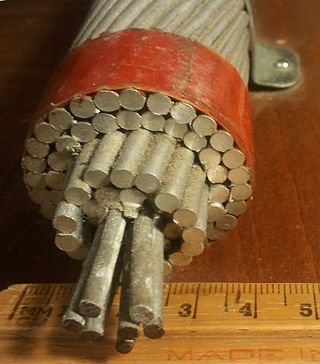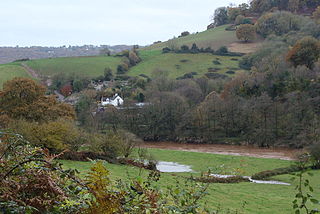Related Research Articles

A wire is a flexible, round, bar of metal. Wires are commonly formed by drawing the metal through a hole in a die or draw plate. Wire gauges come in various standard sizes, as expressed in terms of a gauge number or cross-sectional area.

Calamine is a historic name for an ore of zinc. The name calamine was derived from lapis calaminaris, a Latin corruption of Greek cadmia (καδμία), the old name for zinc ores in general. The name of the Belgian town of Kelmis, La Calamine in French, which was home to a zinc mine, comes from this. In the 18th and 19th centuries large ore mines could be found near the German village of Breinigerberg.
William Humfrey (c.1515–1579) was an English goldsmith, mining promoter, and Assay Master at the Royal Mint during the reign of Elizabeth I.

Tintern is a village in the community of Wye Valley, on the west bank of the River Wye in Monmouthshire, Wales, close to the border with England, about 5 miles (8 km) north of Chepstow. It is popular with tourists, in particular for the scenery and the ruined Tintern Abbey. Modern Tintern has been formed by the coalescence of two historic villages: Tintern Parva, forming the northern end of the village, and Chapel Hill, which forms the southern end. The village is designated as a Conservation Area.

The cementation process is an obsolete technology for making steel by carburization of iron. Unlike modern steelmaking, it increased the amount of carbon in the iron. It was apparently developed before the 17th century. Derwentcote Steel Furnace, built in 1720, is the earliest surviving example of a cementation furnace. Another example in the UK is the cementation furnace in Doncaster Street, Sheffield.
Calamine brass is brass produced by a particular alloying technique using the zinc ore calamine directly, rather than first refining it to metallic zinc. Direct zinc smelting appears to have been unknown in Europe until the mid-18th century, even though the alloyed calamine brass was in use for centuries, and metallic zinc was produced directly via reducing-atmosphere smelting in India and China from the 12th century CE onwards.

Abraham Darby, in his later life called Abraham Darby the Elder, now sometimes known for convenience as Abraham Darby I, was a British ironmaster and foundryman. Born into an English Quaker family that played an important role in the Industrial Revolution, Darby developed a method of producing pig iron in a blast furnace fuelled by coke rather than charcoal. This was a major step forward in the production of iron as a raw material for the Industrial Revolution.

Chilworth is a village in the Guildford borough of Surrey, England. It is located in the Tillingbourne valley, southeast of Guildford.
William Champion (1709–1789) is credited with patenting a process in Great Britain to distill zinc metal from calamine using charcoal in a smelter.
Sir Basil Brooke, English metallurgist and recusant, inherited the manor of Madeley, Shropshire from his father. This contained iron and steel works and coal mines. The coal mines had been worked in his father's time, coal being transported on the River Severn to cities and towns from Shrewsbury to Gloucester.

Osmond iron was wrought iron made by a particular process. This is associated with the first European production of cast iron in furnaces such as Lapphyttan in Sweden.
The Society of the Mines Royal was one of two English mining monopoly companies incorporated by royal charter in 1568, the other being the Company of Mineral and Battery Works.
William Wood (1671–1730) was an English hardware manufacturer, ironmaster, and mintmaster, notorious for receiving a contract to strike an issue of Irish coinage from 1722 to 1724. He also struck the 'Rosa Americana' coins of British America during the same period. Wood's coinage was extremely unpopular in Ireland, occasioning controversy as to its constitutionality and economic sense, notably in Jonathan Swift's Drapier's Letters. The coinage was recalled and exported to the colonies of British America. Subsequently, Wood developed a novel but ineffective means of producing iron, which he exploited as part of a fraudulent investment scheme.
Coslett is an uncommon surname with origins in 16th-century Wales. Main spelling variants are Cosslett and Coslet, though Corslet, Coslette and other spellings have been recorded.

Whitebrook is a small village in Monmouthshire, south-east Wales, United Kingdom. It is located four miles south east of Monmouth in the Wye Valley.

The Wye Valley Railway was a standard gauge railway that ran for nearly 15 miles (24 km) along the Lower Wye Valley between the towns of Chepstow and Monmouth, crossing several times between Wales and England. Opened on 1 November 1876, it was leased to, and worked by, the Great Western Railway (GWR), before being fully absorbed by the GWR in 1905.

A mine railway, sometimes pit railway, is a railway constructed to carry materials and workers in and out of a mine. Materials transported typically include ore, coal and overburden. It is little remembered, but the mix of heavy and bulky materials which had to be hauled into and out of mines gave rise to the first several generations of railways, at first made of wooden rails, but eventually adding protective iron, steam locomotion by fixed engines and the earliest commercial steam locomotives, all in and around the works around mines.
Sir Bevis Bulmer (1536–1615) was an English mining engineer during the reigns of Elizabeth I and James I. He has been called "one of the great speculators of that era". Many of the events in his career were recorded by Stephen Atkinson in The Discoveries and Historie of the Gold Mynes in Scotland, compiled in part from a lost manuscript by Bulmer entitled Bulmer's Skill.
Christopher Schutz (1521–1592) also commonly known in England as Jonas Schutz, was a German-born metallurgist who worked in England for several decades. He built England's first blast furnace at Tintern, and was one of the principal assayers of the worthless ore brought from Baffin Island by Sir Martin Frobisher.

The Goldney family were a wealthy English merchant trading family, most associated with Wiltshire and latterly Bristol. Later branches of the family became the Goldney baronets.
References
- Carr, Cecil T. (1913). Select Charters of Trading Companies A.D. 1530-1707. London: Bernard Quaritch. Retrieved 3 November 2013.
- M. B. Donald, Elizabethan Monopolies (1961).
- H. Hamilton, The English Brass and Copper Industries (1926).
- H. W. Paar and D. G. Tucker, 'The old wireworks and ironworks of the Angidy valley at Tintern, Gwent' Historical Metallurgy 9(1) (1975), 1-14.
- D. G. Tucker, 'The Seventeenth Century Wireworks at Whitebrook Monmouthshire' Historical Metallurgy 7(1), (1973), 28-35.
- W. Rees, Industry before the Industrial Revolution II (1968).
- H.R. Schubert, History of the British Iron and Steel Industry from c.450 to 1775 (1957).
- L. Ince, Neath Abbey and the Industrial Revolution (2001).